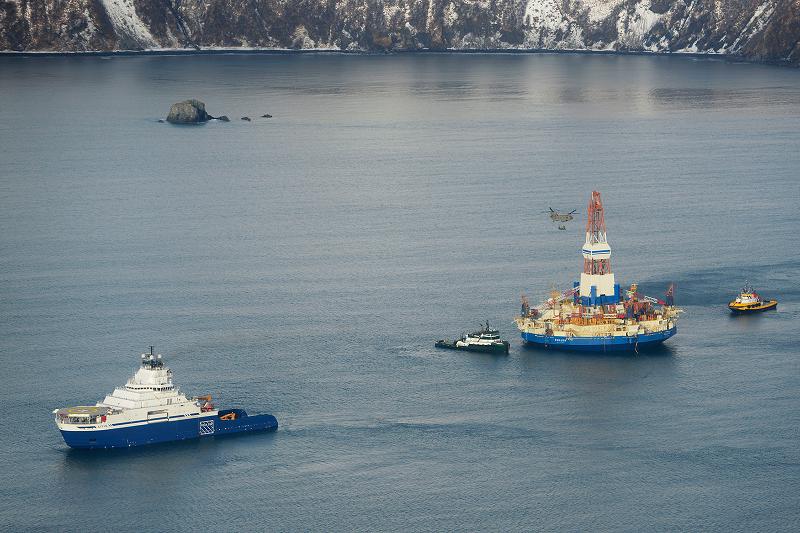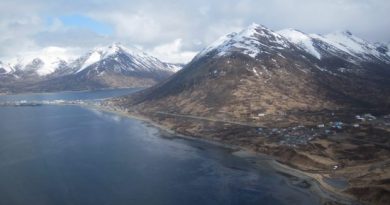Chief engineer says ‘slime’ shut down tug’s engines before Kulluk grounding

(Courtesy Shell, Alaska Dispatch)
An unknown fuel additive that created a “slime” on the Aiviq’s fuel filters likely caused the ship’s engine failures, according to the Aiviq’s chief engineer.
Carl Broekhuis spoke about the failures of the ship’s engines Thursday morning before Coast Guard marine casualty investigators gathered for a hearing in Alaska’s largest city. The engine failures were part of the series of events that led to the grounding of the Kulluk conical drilling rig just hours before the beginning of 2013.
Broekhuis described in detail the problems leading up to the failure of all four of the Aiviq’s engines before Coast Guard marine casualty investigators Thursday.
‘Complex’ vessel
Broekhuis called the Aiviq, specifically designed to tow the Kulluk, a “complex” and “sophisticated” vessel. The trip from Dutch Harbor to Seattle was part of the ship’s maiden season after construction was completed in early 2012.
The 365-foot-long Aiviq was complex because of the sheer amount of equipment aboard the “packed” vessel, Broekhuis testified. There were five thrusters, two drive shafts and a cutting-edge power management system.
But those sophisticated systems weren’t enough to prevent bad fuel from mucking the fuel injectors on the engines in the heavy, rolling seas the ship encountered in the Gulf of Alaska.
MORE COVERAGE: The Kulluk’s forlorn attempt to cross the Gulf of Alaska
Broekhuis found that bad fuel — Broekhuis said samples later showed a “clear, yellowish gel” in the diesel — led to the failure of dozens of fuel injectors on the Shell-owned, Edison Chouest-operated ship.
“I’m not a scientist, but I’m telling you I believe it was something introduced to the fuel (that caused the engine failures,” he said. “I’ve eliminated everything else.”
The chief engineer noted that in normal situations he was informed of any fuel additives added before departure. That didn’t happen before the Aiviq’s left Dutch Harbor on Dec. 21. It’s something, he said, that will be corrected.
“It’s going to be monitored more closely,” Broekhuis said. “I’ll be more insistent on what the additive is because on this batch, I didn’t even know.”
How exactly that will change is still being determined, Broekhuis said. Even months after the incident, he had no indication of what the additive was.
Detailing engine failures
Each engine had 12 injectors — with all or most of them failing shortly after the towline between the Kulluk and Aiviq first broke on Dec. 27.
Engine 2, the first to fail, went down at almost 11 p.m. Dec. 27. Engines 3 and 4 stopped working at 1:45 a.m. the next morning. An hour later, the last engine, No. 1, also quit.
Broekhuis was able to get the No. 1 engine going by 6 a.m., and maintained some control over the Kulluk – via an emergency towline. The Aiviq crew waited for more fuel injectors to be flown to the ship.
By looking at the injectors, and a “slimy” fuel filter, he realized fuel was causing the engine problems and re-rigged the fuel tanks to provide clean fuel to engines.
It was common practice, Broekhuis said, to leave some fuel in a tank after burning. That was to assure that the fuel was good.
“It’s my ‘if I have to’ I know that fuel is good,” he said.
The injectors arrived during the early-morning hours of Dec. 29. By 7:30 a.m., engine No. 4 was up and running, with the other two joining it within hours. By 1:30 p.m. on Dec. 29, all four Aiviq engines were working again.
After the fuel switch and the change of injectors, no further issues with the main engines arose, Broekhuis said.
Broekhuis’ testimony was the first from an Edison Chouest employee on Thursday. The company built the Aiviq tug.
‘I didn’t expect failure’
Later Thursday, a member of the Aiviq crew provided additional testimony on what happened on the vessel, though this time from above the engine room.
Video from the Aiviq offered investigators a peek into the sea weather the two vessels encountered when the towing line snapped. It was part of testimony from Capt. Bobby Newill, a third mate on the Aiviq and the unofficial “anchor captain” who oversaw tow operations.
While most of his early testimony focused on the capabilities of the winch holding the tow line — and the system used to monitor it — later in the day Newill offered a video showing the conditions hours before the line broke.
The cell phone video is less than a minute in length, but it shows the back end of the Aiviq bobbing in the Gulf of Alaska, the Kulluk behind it. The video – Newill said he made it for his wife – then lingers on a computer screen monitoring the tension of the tow line. The numbers vary as the Aiviq moves up and down through choppy water.
Newill said those numbers show that there was no reason to be concerned about the line, which by all accounts seemed stable. The catenary – the curve of the line holding the two ships together, showed no indication of strain.
On Wednesday, the Kulluk rig manager had noted that the ride on Dec. 27 was uneventful leading up to the failure.
Another video, taken from the stern of the ship, shows the line breaking. Newill narrated it, though for the first part he didn’t have much to narrate.
“It’s like watching grass grow,” he said. “There’s nothing unusual.” The video showed the stern of the Aiviq bobbing on ocean swells.
But then the line, which had remained taught against the stern Aiviq, snapped back.
“I see nothing that should have caused that,” Newill said. “… I didn’t expect failure.”
The Coast Guard investigation, led by Cmdr. Josh McTaggart is in the process of conducting a marine casualty hearing on the Kulluk. The group hopes to uncover what went wrong and, ultimately, who is responsible for the grounding of the conical drilling unit, considered a centerpiece of Shell’s Arctic drilling operation.
All Shell drilling off Alaska in 2013 was suspended earlier this year.
Any recommendations will be passed on to Rear Adm. Thomas Ostebo, who will decide whether or not to make changes to regulations or pursue criminal charges.
Contact Suzanna Caldwell at suzanna(at)alaskadispatch.com



